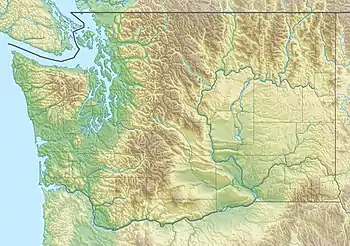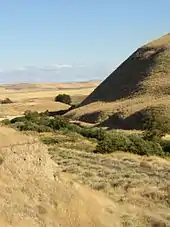Touchet River
The Touchet River /ˈtuːʃi/ is a 55-mile (89 km) tributary of the Walla Walla River in southeastern Washington in the United States.
| Touchet River | |
|---|---|
 Near Lamar Cabin in autumn | |
 Location of the mouth of the Touchet River in Washington | |
| Location | |
| Country | United States |
| State | Washington |
| County | Walla Walla, Columbia |
| Physical characteristics | |
| Source | Confluence of North and South forks, Touchet River |
| • location | Dayton, Columbia County |
| • coordinates | 46°18′05″N 117°57′32″W[1] |
| • elevation | 1,671 ft (509 m)[2] |
| Mouth | Walla Walla River |
• location | Touchet, Walla Walla County |
• coordinates | 46°02′01″N 118°40′59″W[1] |
• elevation | 430 ft (130 m)[1] |
| Length | 55 mi (89 km)[3] |
| Basin size | 740 sq mi (1,900 km2) |
The upper Touchet was a traditional summer meeting place for trade and games for the Palus, Nez Perce and Walla Walla tribes. The name Touchet derives from the similarly pronounced Sahaptin term for the river, Tu-se meaning roasting. Nez Perce legend tells that coyote roasted salmon at this river after breaking a fish dam guarded by the seven swallow sisters at Celilo.
The USGS cited two variant names, Pouchet River and Toosha River.[1]
Geography
The Touchet River drains an area of about 740 square miles (1,900 km2).[4][5] The main stem is 55 miles (89 km) long.[3] The average annual flow of the Touchet is 6.23 m³/s (220 ft³/s), not including diversions.[6]
Its headwaters lie in the Umatilla National Forest which is located in the Blue Mountains in Columbia County, southern Washington. It originates above the town of Dayton, Washington. It then passes through Waitsburg and Prescott before joining the Walla Walla at the town of Touchet, Washington.[4][5]
The main Touchet River is formed by the confluence of the North Fork of the Touchet which originates in the vicinity of the Bluewood Ski Area, and the South Fork of the Touchet which originates at Deadman Peak. The forks join about 2 miles (3 km) south of (upstream of) Dayton. The North Fork is about 25 miles (40 km) long and the South Fork about 20 miles (32 km) long. Other tributaries include Patit Creek, which joins the Touchet at Dayton; Coppei Creek, which enters at Waitsburg, and Whetstone Creek, which joins the Touchet at Prescott.[4][5]
Recreation
The Touchet is known for its rainbow and cutthroat trout fishing, especially in the upper and middle reaches.
Summer steelhead, which like salmon are anadromous, and Chinook salmon spawn throughout a large portion of the middle and upper reaches of the Touchet River drainage, the population is imperiled in the 21st century. The Nine Mile Dam, constructed in 1905 on the Walla Walla River below the confluence with the Touchet River, impeded anadromous fish migration into the Touchet, but a wild steelhead population (listed as threatened under the Endangered Species Act) continues to return to the river.
History
Native peoples

The Touchet River lay in the traditional range of the Palus American Indian tribe, marking their southern border with the range of the Walla Walla tribe. These peoples were of the Sahaptin-speaking group which traditionally inhabited the Columbia Plateau region of the northwestern United States.
Roots provided plentiful food along the Touchet Rivers. These included quamash, camas, kouse, bitterroots, serviceberry (currant), chokecherry, huckleberry, gooseberries, rose berries and whortleberries, elderberries, wild strawberries, wild onions and balsamroot. Once Euroamerican immigrants began settling the area after 1858, Indian root grounds were displaced by agriculture.
Prior to the white man coming into the valley of the Touchet River, there was an established American Indian trail through the valley, the Nez Perce Trail to Celilo Falls or Old Celilo Falls Trail, by which the Nez Perce (also part of the Sahaptin-speaking group) passed west to fish for salmon at Celilo Falls on the Columbia River. As with other Sahaptin-speaking peoples, the Nez Perce were migratory, returning to the same locations year after year; Celilo Falls lay at the western end of their annual range.[7]
Lewis and Clark expedition
On their return journey in 1806, the Lewis and Clark Expedition followed the Old Celilo Falls Trail, up the Walla Walla and Touchet River Valleys; they camped on the Touchet about 12 miles (19 km) north of today's town of Touchet on April 30, 1806.[8] The Lewis and Clark Trail State Park commemorates their May 1, 1806 campsite on the Touchet River.[9] The expedition left the Touchet River to follow a tributary, Patit Creek, at what is now Dayton. They camped about 2 miles (3 km) above modern-day Dayton on Patit Creek on May 2, 1806, before following the trail across country to the Tucannon River.[10]
Early settlement
The Whitman Mission catalyzed white settlement of the region, beginning in 1843 when 1,000 people, 120 wagons, and approximately 5,000 horses and cattle came to the Walla Walla valley.[11] The initial settlers remained near the current city of Walla Walla and into the Touchet River valley.[12]
Later settlement

The Lamar Cabin, built in 1863 of hand-hewn cottonwood logs from the Touchet River valley by George Dudley Goodwin, became the home of the bachelor brothers James and Joseph Lamar in 1872 (women were rare in the valley and many men remained unmarried). The brothers initially raised sheep and horses; in later years they, mirroring the transitions of many others in the region, cultivated dryland winter wheat. This area developed into the town of Lamar when the Hunt Railroad was built along the Touchet River valley in 1888. The railway left the Touchet River and continued west at Lamar at the point where the Touchet River turns south to meet the Walla Walla. Although the town site is now virtually abandoned, the historic Lamar cabin is preserved to this day (see photo).
Near the head of the Touchet valley, Dayton was officially incorporated on November 10, 1881.
See also
References
- "Touchet River". Geographic Names Information System. United States Geological Survey. September 10, 1979. Retrieved February 1, 2013.
- Source elevation derived from Google Earth search using GNIS source coordinates.
- United States Geological Survey. "United States Topographic Map". TopoQuest. Retrieved February 1, 2013. River miles are marked and numbered on the relevant map quadrangles.
- Cohen, Saul B. Editor (1962). Gazetteer of the Word. Columbia University Press, New York. ISBN 0-231-11040-5.
- Washington Road & Recreation Atlas, Benchmark Maps, Medford, Oregon, 2002
- Records of the POLLUTION CONTROL HEARINGS BOARD, State of Washington Archived 2007-06-03 at the Wayback Machine
- Trafzer, C.E. & Scheuerman, R.D. (1986). Renegade Tribe; The Palouse Indians and the Invasion of the Inland Pacific Northwest. Washington State University Press, Pullman, Washington. ISBN 0-87422-027-0.
- Lewis & Clark on April 30, 1806
- "Lewis & Clark Trail campsite on the Touchet River". Archived from the original on 2006-09-23. Retrieved 2006-09-24.
- Moulton, Gary E. (1991). The Journals of the Lewis & Clark Expedition: March 23 – June 9, 1806. University of Nebraska Press, Lincoln, Nebraska. ISBN 0-8032-2898-8.
- Evans, J. W. (1991). Powerful Rockey: The Blue Mountains and the Oregon Trail, 1811-1883. Eastern Oregon State College, La Grande, Oregon. ISBN 0-9626772-0-5.
- Lyman, W. D. (1918). Lyman's History of Old Walla Walla County, Embracing Walla Walla, Columbia, Garfield and Asotin Counties. S. J. Clarke, Chicago. ISBN none.
External links
| Wikimedia Commons has media related to Touchet River and Formation. |
